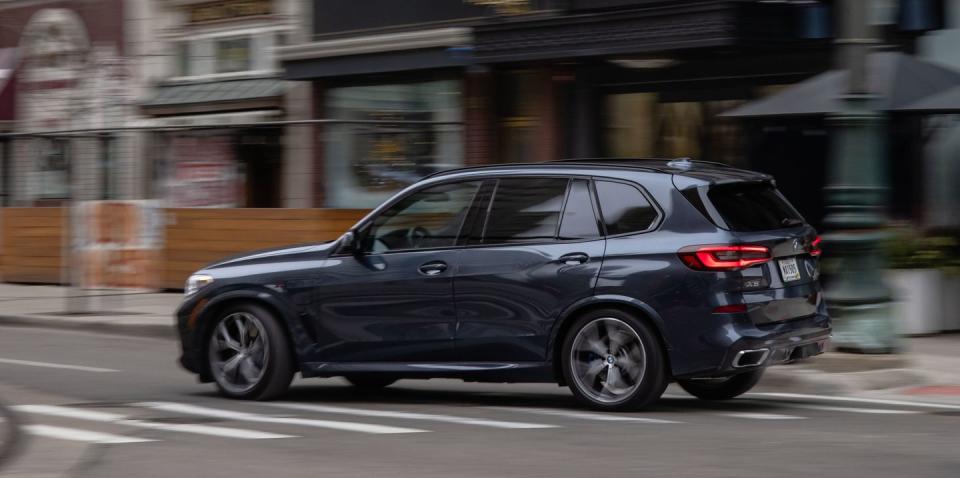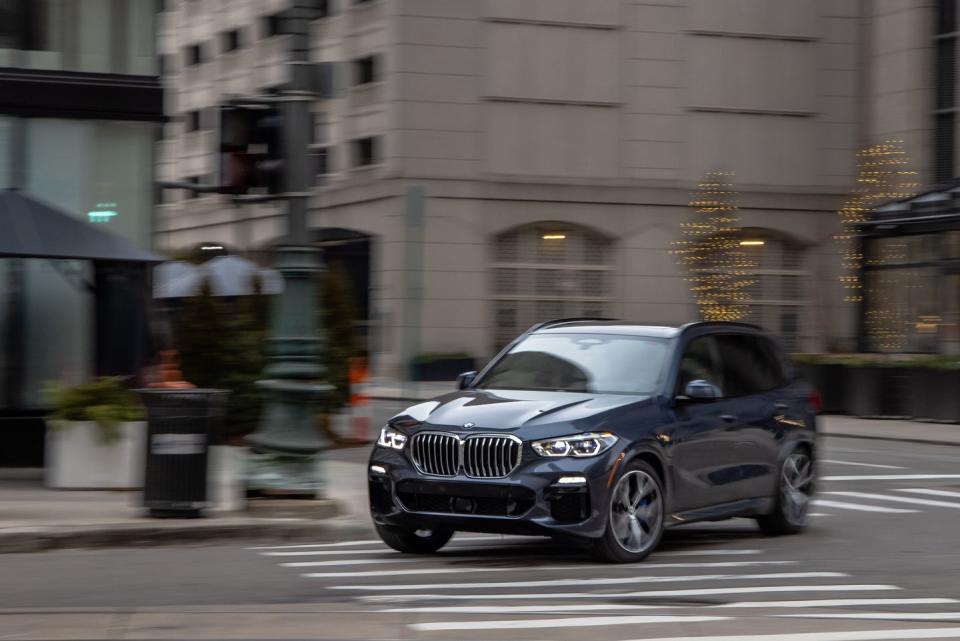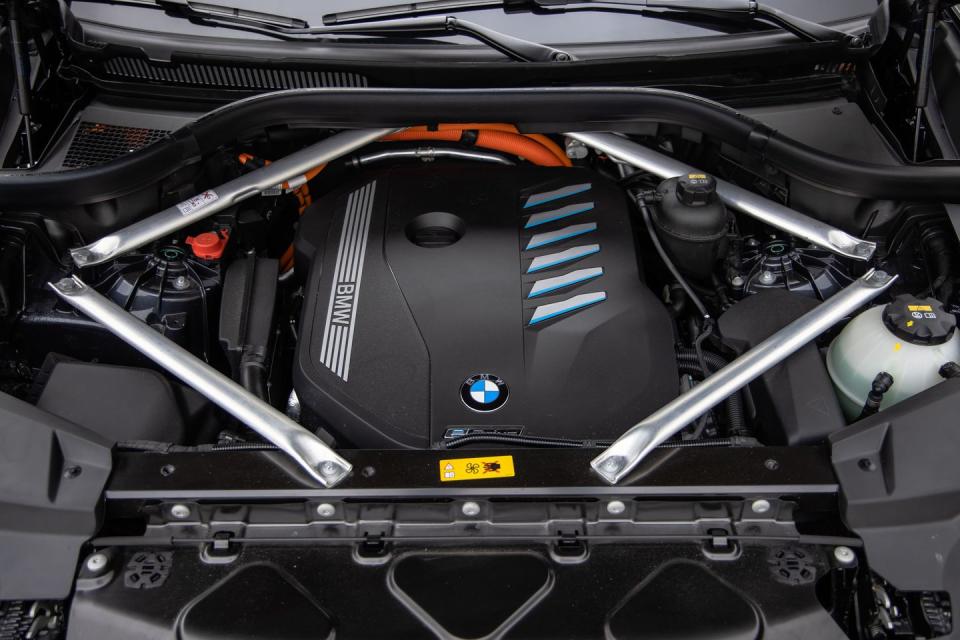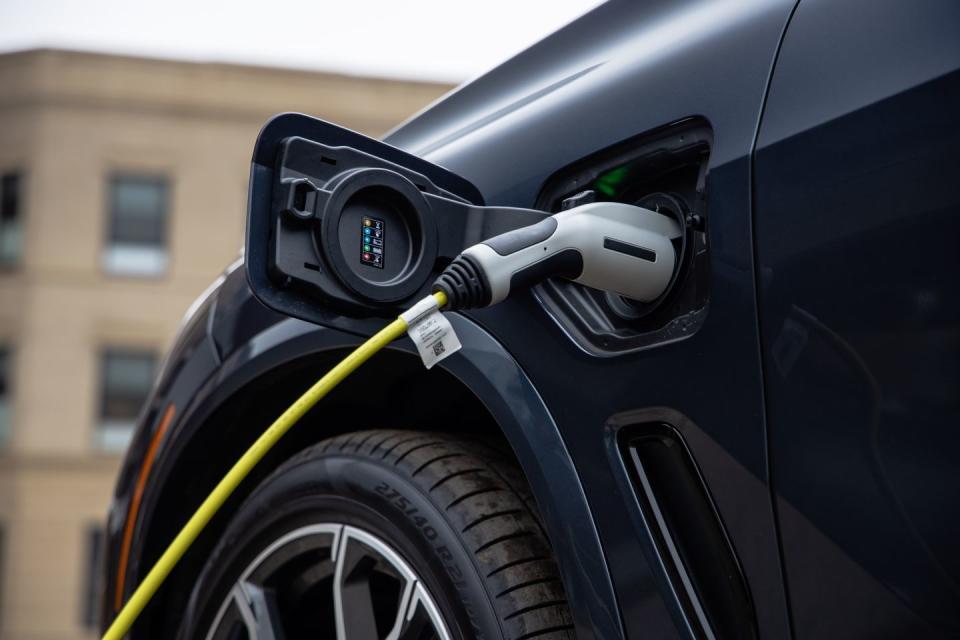Tested: 2021 BMW X5 xDrive45e Prioritizes Quickness and Range

The term "plug-in hybrid electric vehicle" is a catchall that's applied to vehicles with wildly different missions and designs. The Porsche 918 Spyder is a PHEV, as is the late Chevrolet Volt and the Polestar 1. Most PHEV buyers are probably looking for improved fuel economy and a possible reduction in judgmental side-eye in the local Whole Foods parking lot, but BMW's electrified 2021 BMW X5, the xDrive45e, actually earns a worse EPA combined number than the non-hybrid xDrive40i. However, the plug-in delivers an EPA rated 31 miles of electric range, along with a $7500 federal tax credit. The promise of this particular PHEV is that you get normal X5 performance and capability in a package that can moonlight as an electric vehicle.
A Quicker and Silkier Gas-Electric Tandem
A 282-hp turbocharged 3.0-liter inline-six now sits between this X5's fenders, supplanting the previous-generation X4 40e's 240-hp 2.0-liter turbo four. Paired with a single electric motor, which is sandwiched between the engine and the eight-speed automatic transmission, the new straight-six helps generate a combined 389 horsepower and 443 pound-feet of torque (up 81 and 111, respectively). While PHEV skeptics might worry that electrification will interrupt the six's silky power delivery, the gas engine, electric motor, and the transmission are as harmonious as the Bee Gees singing "Stayin' Alive." The straight-six is a remarkable eight decibels quieter at idle than the four-pot, and while it produces an extra four decibels at wide-open throttle, the soundtrack is rich rather than coarse.

Aided by the traction of our example's optional Pirelli P Zero PZ4 summer tires and the standard all-wheel-drive system—which is fully operational even in electric-only mode—the X5 xDrive45e bolted to 60 mph in 4.7 seconds. That's 1.4 seconds quicker than a 2016 x540e we tested. The big Bimmer is also quicker to 60 mph and in the quarter-mile than some electrified rivals, including the Lincoln Aviator Grand Touring, Range Rover Sport 400e, and Volvo XC90 T8. However, if a Porsche Cayenne E-Hybrid driver wants to race to the next stoplight, we'd recommend pretending not to notice. Even the non-Turbo-badged Cayenne plug-in is one quick machine, launching to 60 mph in 4.2 seconds and completing the quarter-mile in 12.8 clicks (0.6 second ahead of the X5 45e).
Despite weighing 5627 pounds—755 pounds more than a nonhybrid X5 xDrive40i—the plug-in version is surprisingly composed and nimble. Its steering feels natural and precise, and its lack of feedback is the norm for luxe SUVs. Adaptive dampers and an adjustable air suspension that can be raised or lowered 1.6 inches are standard. Our version had the $5500 M Sport package, which is mostly just a cosmetic upgrade, but it also included the $950 staggered 21-inch wheels, sized 275/45R-21 front and 315/45R-21 rear. While they have a shorter sidewall than the standard 19-inchers (or the 20s that come with the M Sport package), they had a negligible effect on ride quality and a positive impact on performance. Combined with the $650 M Sport brakes, the plug-in X5 stopped from 70 mph in a sports-car-like 156 feet. Unfortunately, the brake pedal suffers from hybrid regenerative tuning and is excessively squishy and awkward to operate in stop-and-go traffic.

Longer All-Electric Range, but Lower Fuel Economy
Compared with the old X5 40e, the xDrive45e receives a larger lithium-ion battery that sees its usable capacity increase from 6.8 kWh to 17.1 kWh. This gives it an EPA-rated all-electric range of 31 miles (up from 14). That's notable because it's at least eight; miles more range than you get in any other plug-in-hybrid BMW, and it's also at least 10 miles higher than every other plug-in mid-size luxury SUV. Good thing for all of them that the Toyota RAV4 Prime, with its 42 miles of EV range, plays in a different market.

On our 200-mile highway fuel-economy test, the fully charged X5 xDrive45e ran for 25 miles on battery power and delivered 46 MPGe, close to its combined EPA rating of 50 MPGe. That MPGe number is important, given that the Bimmer's traditional EPA ratings of 19 mpg city and 22 highway are actually lower than those of the nonhybrid X5 xDrive40i (21 mpg city and 25 highway). The 45e doesn't offer a performance advantage, either, with both X5s posting identical acceleration times. However, the plug-in-hybrid version can be a unique value. The xDrive45e starts at $66,395, but it's the only PHEV in its class that's eligible for a full $7500 federal tax credit. That drops its price tag (before options) to $58,895, which is $1500 cheaper than the rear-drive X5 40i and $3800 less than the xDrive40i.
Our lavishly optioned Artic Grey xDrive45e carried an as-tested price of $81,695, without the tax credit. Strip away the superfluous M Sport add-ons ($7100 combined) and the $1700 Driver Assistance Professional package and the price becomes more palatable. Still, we'd recommend the Vernasca leather upholstery option, since the standard synthetic leather is at odds with the otherwise upscale cabin. Along with the beautifully rendered 12.3-inch digital gauge cluster, there's a 12.3-inch touchscreen that features wireless Android Auto and Apple CarPlay. Back-seat passengers have bountiful headroom, but the seats aren't adjustable and stretch-out space is limited. In this class, only the Aviator and XC90 have a third row. Surprisingly, the BMW's battery—located under the cargo floor—only steals 1 cubic foot of cargo volume versus the nonhybrid version, and those 33 cubes held nine carry-on suitcases.

So, if the xDrive45e looks like a non-hybrid X5 and performs like one, is this all an elaborate Rube Goldberg approach to a tax credit? Not if you can put that EV range to use. Assuming your daily routine covers fewer than 31 miles and you have access to a charger, a electrified X5 could serve as an EV on the weekdays and a powerful luxury hybrid on longer weekend trips. The caveat here is that the electric motor produces only 111 horsepower and 77 pound-feet of torque, resulting in an EV-mode power-to-weight ratio that makes a 1998 Geo Metro look like a Bugatti. Fortunately, the motor's position upstream of the transmission means that it can use all eight gears to its advantage, enabling a top speed of 84 mph and reasonably okay acceleration in around-town circumstances. Still, a kickdown switch means that a deep-enough stab at the accelerator will fire the straight-six even in EV mode, which might be annoying to hypermilers but a boon when you're trying to merge onto the highway with a rearview filled with Peterbilt.
Some PHEVs are clearly optimized for performance. Others strive for ultimate efficiency. The X5 xDrive 45e doesn't really fit into either category—it's not the performance flagship of its lineup, and in hybrid mode it can't match the fuel economy of the non-hybrid. Where it makes its case is as a part-time EV, silently plying the suburbs and school drop-off lines, until it's time to light the fuse on 389 horsepower and drive it like a BMW.
You Might Also Like

 Yahoo Finance
Yahoo Finance 